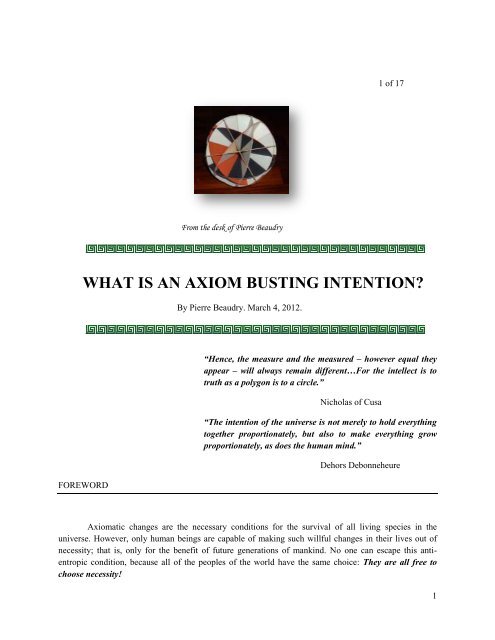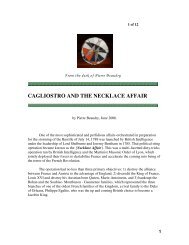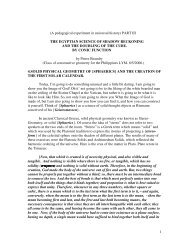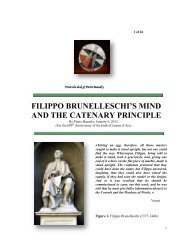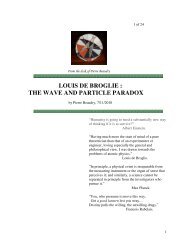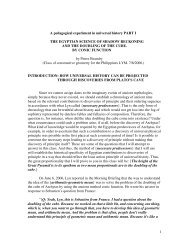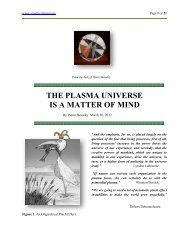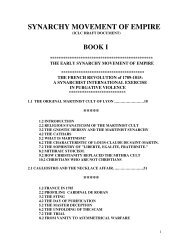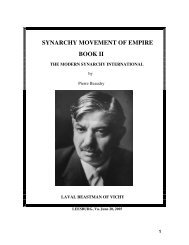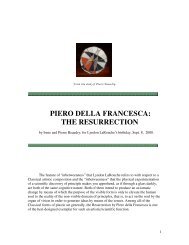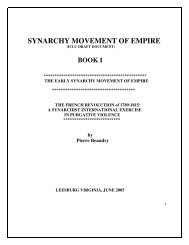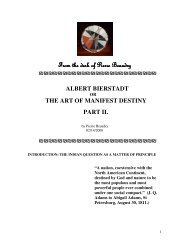what is an axiom busting intention? - Pierre Beaudry's Galactic ...
what is an axiom busting intention? - Pierre Beaudry's Galactic ...
what is an axiom busting intention? - Pierre Beaudry's Galactic ...
Create successful ePaper yourself
Turn your PDF publications into a flip-book with our unique Google optimized e-Paper software.
1 of 17<br />
From the desk of <strong>Pierre</strong> Beaudry<br />
WHAT IS AN AXIOM BUSTING INTENTION?<br />
By <strong>Pierre</strong> Beaudry. March 4, 2012.<br />
FOREWORD<br />
“Hence, the measure <strong>an</strong>d the measured – however equal they<br />
appear – will always remain different…For the intellect <strong>is</strong> to<br />
truth as a polygon <strong>is</strong> to a circle.”<br />
Nicholas of Cusa<br />
“The <strong>intention</strong> of the universe <strong>is</strong> not merely to hold everything<br />
together proportionately, but also to make everything grow<br />
proportionately, as does the hum<strong>an</strong> mind.”<br />
Dehors Debonneheure<br />
Axiomatic ch<strong>an</strong>ges are the necessary conditions for the survival of all living species in the<br />
universe. However, only hum<strong>an</strong> beings are capable of making such willful ch<strong>an</strong>ges in their lives out of<br />
necessity; that <strong>is</strong>, only for the benefit of future generations of m<strong>an</strong>kind. No one c<strong>an</strong> escape th<strong>is</strong> <strong>an</strong>tientropic<br />
condition, because all of the peoples of the world have the same choice: They are all free to<br />
choose necessity!<br />
1
If people don’t choose to ch<strong>an</strong>ge, they r<strong>is</strong>k going down with the current h<strong>is</strong>torical breakdown, <strong>an</strong>d<br />
become extinct like the proverbial Dodo bird. However, if you look at the optim<strong>is</strong>tic side, the current<br />
strategic situation <strong>is</strong> a universal condition that no one c<strong>an</strong> afford to m<strong>is</strong>s, because, if you were to<br />
successfully go through the current strategic ch<strong>an</strong>ge, your will have contributed to your species’<br />
immortality. Th<strong>is</strong> report contains five sections:<br />
1. CREATE CHANGE BY ENFOLDING, NEVER BY UNFOLDING<br />
2. PLATO’S CAVE, METAPHOR, AND THE INTENTION OF GEOMETRY<br />
3. THE PLATONIC SOLIDS AND THE MUSIC OF THE SPHERES.<br />
4. WHAT IS THE PLASMA DYNAMICS CALLED HELIOSEISMOLOGY?<br />
5. ELECTROMAGNETIC UNIPOLAR INDUCTION AND COSMIC PLASMA.<br />
1- CREATE CHANGE BY ENFOLDING, NEVER BY UNFOLDING.<br />
Let me explain why you always have to start <strong>an</strong>ything from the end. Start with the <strong>intention</strong> of<br />
drawing a line with a moving point as <strong>an</strong> example. People think wrongly that a moving point <strong>is</strong> <strong>what</strong><br />
creates a line, that a moving line creates a surface, <strong>an</strong>d that a moving surface creates a solid. That <strong>is</strong><br />
incorrect. In fact, all things are created from the higher <strong>intention</strong> of their creator; that <strong>is</strong> to me<strong>an</strong>, from the<br />
top down, from a higher m<strong>an</strong>ifold to a lower m<strong>an</strong>ifold, never from the lower to the higher m<strong>an</strong>ifold. In<br />
other words, the universe c<strong>an</strong> only be understood if you start from the <strong>intention</strong>, never from so-called<br />
building blocks, which <strong>is</strong> the generalized fallacy of composition that ex<strong>is</strong>ts everywhere in society, today.<br />
Trying to underst<strong>an</strong>d the universe from building blocks <strong>is</strong> to believe that one c<strong>an</strong> attain the next<br />
higher state of ex<strong>is</strong>tence by starting from the beginning, <strong>an</strong>d proceeding from the bottom to the top. That<br />
<strong>is</strong> completely wrong. A house must always be built from the roof down. See my report on Brunelleschi’s<br />
Mind. And the reason one c<strong>an</strong>not succeed by starting to build a house from the basement up <strong>is</strong> the same<br />
reason that forbids you to create a line from <strong>an</strong> infinite number of points, a surface from <strong>an</strong> infinite<br />
number of lines, <strong>an</strong>d a solid from <strong>an</strong> infinite number of surfaces. Cusa identified two opposite movements<br />
in the mental process of constructing <strong>an</strong>ything; one which proceeds as <strong>an</strong> enfolding (complicatio) from<br />
the top down, <strong>an</strong>d the other which proceeds from <strong>an</strong> unfolding (explicatio), from the bottom up. In the<br />
creative process of the mind, as in the universe as a whole, the process of creation always begins with<br />
enfolding <strong>an</strong>d never with unfolding. As Cusa put it:<br />
“When I claim in geometry that the total perfection of the line ex<strong>is</strong>ts from th<strong>is</strong> point A to<br />
point B, I have designated through point A <strong>an</strong>d B the totality of the line before it <strong>is</strong> drawn from A<br />
to B. That <strong>is</strong>, the line ought not to be drawn beyond them. Consequently, to enclose the totality of<br />
a line either in actuality or in the intellect, between th<strong>is</strong> place <strong>an</strong>d that, <strong>is</strong> to enfold the line in the<br />
point. To unfold, however, <strong>is</strong> to draw the line consecutively from A to B. Accordingly; the line<br />
unfolds the enfolding of the point.” (Nicholas of Cusa, The Laym<strong>an</strong>: About Mind, Abar<strong>is</strong> Books,<br />
New York, 1979, p. 72.)<br />
2
When you draw a line on a piece of paper, you are unfolding <strong>what</strong> has already been enfolded in<br />
the point of your pen by the <strong>intention</strong> of the higher domain of your mind from the future. Thus, the<br />
creative process starts with the enfolding of the <strong>intention</strong> from the top down; that <strong>is</strong>, from the final cause<br />
<strong>an</strong>d never from the so-called efficient cause. You c<strong>an</strong>not create <strong>an</strong>ything by unfolding efficient causes.<br />
That <strong>is</strong> not <strong>an</strong> efficient way of dealing with causality at all, because you are merely pushing things one<br />
against the other, like dominos. Creativity <strong>is</strong> never unfolding, because unfolding <strong>is</strong> based on senseperception<br />
practicality, which proceeds from the past to the future. That never gets you <strong>an</strong>ywhere. If you<br />
start <strong>an</strong>ything like th<strong>is</strong>, you will never get to the end of it. Enfolding, on the other h<strong>an</strong>d, <strong>is</strong> based on the<br />
<strong>intention</strong> of the creative mind which proceeds by time reversal, from the end, <strong>an</strong>d works back from the<br />
future to the past. That <strong>is</strong> the only way to go forward.<br />
For inst<strong>an</strong>ce, a polygon c<strong>an</strong> never become a circle, <strong>an</strong>d a polyhedron c<strong>an</strong> never become a sphere,<br />
even though they are both created with the <strong>intention</strong> of that aspiration in them. Always start with<br />
<strong>intention</strong>, because it <strong>is</strong> only with <strong>intention</strong> that you c<strong>an</strong> get to accompl<strong>is</strong>h <strong>an</strong>ything. Such <strong>is</strong> the difference<br />
between the measure <strong>an</strong>d the measured. Creativity must start with enfolding, because there <strong>is</strong> always<br />
more in the measure th<strong>an</strong> there <strong>is</strong> in the measured. As Cusa noted: “For mind conforms itself to<br />
possibility so that it may measure everything as possible. It conforms itself to absolute necessity so that it<br />
may measure everything simply <strong>an</strong>d as one, just as God does.” (Ibid., p. 74) Ep<strong>is</strong>temology, therefore,<br />
must be understood as the psycho<strong>an</strong>alys<strong>is</strong> of s<strong>an</strong>e minds.<br />
2. PLATO’S CAVE, METAPHOR, AND THE INTENTION OF GEOMETRY.<br />
When I beg<strong>an</strong> to investigate the <strong>intention</strong> of the Five Platonic Solids, in 1992, all I had was a<br />
bunch of questions. For example: What <strong>is</strong> the <strong>intention</strong> of geometry? What <strong>is</strong> its purpose? What <strong>is</strong><br />
geometry supposed to teach us, exactly? And, my <strong>an</strong>swers were all coming back to the same thing, which<br />
was that geometry’s <strong>intention</strong> <strong>is</strong> to demonstrate how the universe ch<strong>an</strong>ges, not how it <strong>is</strong>. If I describe<br />
how the world <strong>is</strong>, that <strong>is</strong> stupid, because I merely show how it <strong>is</strong> falling apart. The key to geometry <strong>is</strong> to<br />
show how to ch<strong>an</strong>ge the world. So, how was I going to express that? How c<strong>an</strong> you represent ch<strong>an</strong>ge,<br />
when it <strong>is</strong> so fugitive <strong>an</strong>d geometry <strong>is</strong> so static? How c<strong>an</strong> geometry show ch<strong>an</strong>ge when all it c<strong>an</strong> do <strong>is</strong> to<br />
show that ch<strong>an</strong>ge <strong>is</strong> <strong>an</strong> inv<strong>is</strong>ible jump from rest to rest? “THAT’S IT,” I said to myself. That <strong>is</strong> when I<br />
realized that geometry could never be a curve fitting me<strong>an</strong>s of describing our ch<strong>an</strong>ging reality, but could<br />
only be a blind m<strong>an</strong>’s stick on the bumpy road of time reversal. “Oh wonderful flaw that gave us time as a<br />
measure of ch<strong>an</strong>ge,” I thought to myself.<br />
From that moment on, my task was to d<strong>is</strong>cover how geometric devices could express ch<strong>an</strong>ge by<br />
showing how they fail to make leaps <strong>an</strong>d jumps between one state of ex<strong>is</strong>tence to <strong>an</strong>other totally different<br />
state of ex<strong>is</strong>tence, like going from two dimensions to three dimensions. But, how was I going to express<br />
that crazy idea, geometrically? At Lyn’s suggestion, I decided to look for those singularities <strong>an</strong>d<br />
d<strong>is</strong>continuities of <strong>axiom</strong>atic ch<strong>an</strong>ge that represented paradoxes <strong>an</strong>d ironies in mental processes. In other<br />
words, I decided that not only Leibniz, but also Cusa <strong>an</strong>d Plato were right, <strong>an</strong>d that the truth of the matter<br />
was that the real ch<strong>an</strong>ges in the world had to be represented, one way or <strong>an</strong>other, by our experimental<br />
3
failures in Plato’s Cave. “Looking through a glass darkly” as in learned ignor<strong>an</strong>ce became a new way to<br />
see the truth of the world by looking for <strong>what</strong> was not there for us to know.<br />
The <strong>intention</strong> of geometry, therefore, became as Lyn said at that time, a metaphorical journey. I<br />
refer to Lyn’s piece ON THE SUBJECT OF METAPHOR (1992). Lyn’s paper on geometry confirmed<br />
th<strong>is</strong> question of ch<strong>an</strong>ge in spades. So, th<strong>is</strong> being the case, I asked myself: Where c<strong>an</strong> I find the metaphors<br />
representing the principle of m<strong>an</strong>ifold ch<strong>an</strong>ge through Plato’s Cave? And the best place I found to look<br />
for those paradoxes <strong>an</strong>d ironies was in universal h<strong>is</strong>tory <strong>an</strong>d in the principle of <strong>an</strong>cient architecture, most<br />
surpr<strong>is</strong>ingly inside the Great Pyramid of Egypt. I d<strong>is</strong>covered the most improbable m<strong>is</strong>sing link between<br />
Egypt <strong>an</strong>d Greece. I came to underst<strong>an</strong>d the role of geometry in science <strong>an</strong>d art as the method to d<strong>is</strong>cover<br />
the impossible, the unbelievable. Then, my mind went into a very nice knot like a spinning braided<br />
Birkel<strong>an</strong>d current: the ch<strong>an</strong>ge of geometry became the geometry of ch<strong>an</strong>ge.<br />
Now, let me illustrate th<strong>is</strong> with one of my favorite geometric devices. The key to doing properly<br />
<strong>what</strong> I am doing was to d<strong>is</strong>cover the gestalt, the One of the M<strong>an</strong>y, the unity of effect of a higher<br />
integration. About twenty years ago, I d<strong>is</strong>covered that the best way to express the metaphor of Plato’s<br />
Cave was by using the shadows that were projected from the outside of that cave by a single sphere. Th<strong>is</strong><br />
was suggested to me when I noticed that a unique sphere representing the Platonic Solids was m<strong>is</strong>sing in<br />
Lyn’s 1992 paper on metaphor. I was shocked to d<strong>is</strong>cover that past geometers had never succeeded in<br />
d<strong>is</strong>covering th<strong>is</strong> integrating sphere during over more th<strong>an</strong> two thous<strong>an</strong>d years. It took me a while to<br />
d<strong>is</strong>cover that the reason for th<strong>is</strong> m<strong>is</strong>sing sphere was that those geometers were looking for ways to<br />
express a geometric curve fitting between the Platonic Solids <strong>an</strong>d physical reality, while I was looking for<br />
a metaphor to express <strong>an</strong> <strong>axiom</strong>atic ch<strong>an</strong>ge between the shadows of sense-perception <strong>an</strong>d the creative<br />
hum<strong>an</strong> mind. Everybody was looking for a physical correspondence between geometry <strong>an</strong>d reality; I was<br />
seeking the opposite. I was looking for <strong>an</strong> ep<strong>is</strong>temological d<strong>is</strong>continuity between them.<br />
When I f<strong>is</strong>t constructed my original 10-Circle Egypti<strong>an</strong> Sphere, in 1992, <strong>an</strong>d showed it to Lyn, he<br />
only replied with one word: “Th<strong>is</strong> pertains to C-256.” I was elated. My <strong>intention</strong>, however, was not to<br />
represent some musical theory, or some atomic theory, but rather to represent the unity of a generative<br />
spherical principle generating <strong>an</strong> <strong>axiom</strong>atic ch<strong>an</strong>ge. I knew that such a sphere had to ex<strong>is</strong>t in <strong>an</strong>cient<br />
times, because the <strong>axiom</strong>atic ch<strong>an</strong>ge represented by the <strong>intention</strong> of the Great Pyramid of Egypt, the<br />
<strong>intention</strong> of the Doubling of the Cube by Archytas, <strong>an</strong>d the <strong>intention</strong> of the Five Regular Platonic Solids<br />
were all very real to me, more real, even, th<strong>an</strong> the physical reality I was trampling under my feet.<br />
I realized, then, that if I could demonstrate the ex<strong>is</strong>tence of such <strong>an</strong> <strong>axiom</strong>atic ch<strong>an</strong>ge,<br />
constructively, that <strong>is</strong>, by showing how a single sphere generates all possible polyhedra, for example, I<br />
would have the metaphor I was looking for. But, to my surpr<strong>is</strong>e, it wasn’t just polyhedra that th<strong>is</strong> amazing<br />
sphere was capable of enfolding. The irony was that the 10-circle sphere was also capable of enfolding<br />
the <strong>an</strong>gular determination of the Great Pyramid of Egypt, <strong>an</strong>d show how the first great astronomical<br />
observatory in the world was created with the musical harmonic proportionality of the equal-tempered<br />
system.<br />
The connection between the Angular determination of the Great Pyramid of Egypt <strong>an</strong>d the<br />
Doubling of the Cube by Archytas was going to complicate matters even further, because Archytas had<br />
already complicated h<strong>is</strong> own model with the intersections of a Cone, a Cylinder, <strong>an</strong>d a Torus. I beg<strong>an</strong> to<br />
realize that <strong>what</strong> I had in my h<strong>an</strong>ds was the m<strong>is</strong>sing link between Ancient Egypt, Ancient Greece, <strong>an</strong>d<br />
4
modern times from Cusa to Einstein. What made th<strong>is</strong> d<strong>is</strong>covery even more interesting, however, from the<br />
v<strong>an</strong>tage point of Cusa, was that Archytas had also enfolded h<strong>is</strong> own construction from a conical musical<br />
r<strong>an</strong>ge that divided the classical octave into three intervals of the same equal-tempered major thirds as I<br />
had found in the mid-section of the Great Pyramid. You could not get more closure th<strong>an</strong> that. That was<br />
the link I had been looking for, which represented the mental proportion underlying the projective<br />
structure of Plato’s Cave. The universal progress of ideas, the very h<strong>is</strong>tory of ideas, seemed to be holding<br />
together through th<strong>is</strong> very thinly d<strong>is</strong>gu<strong>is</strong>ed inferential function.<br />
Figure 1. The <strong>an</strong>gle of the Great pyramid of Egypt <strong>an</strong>d the Doubling of the Cube. The proportionality of solid<br />
growth <strong>is</strong> expressed by the perpendicular cross-section of the Great Pyramid of Egypt circumscribed by a circle.<br />
That <strong>is</strong>: AB : AM :: AM : AP :: AP : AC, which <strong>is</strong> the same biquadratic relationship as the Archytas Doubling of<br />
the Cube. What th<strong>is</strong> proportionality says <strong>is</strong> that AB <strong>is</strong> to AM as AM <strong>is</strong> to AP in the same proportion that AP <strong>is</strong> to<br />
AC. In other words, the radius of the circumscribing circle <strong>is</strong> to the height of the Great Pyramid as the height of the<br />
Great Pyramid <strong>is</strong> to its sl<strong>an</strong>ted side, in the same proportion that the sl<strong>an</strong>ted side <strong>is</strong> to the diameter of the<br />
circumscribing circle.<br />
Thus, it became clear that <strong>what</strong> the Great Pyramid of Egypt <strong>an</strong>d the Pythagore<strong>an</strong> Archytas<br />
d<strong>is</strong>covery of Doubling the Cube represented for hum<strong>an</strong> civilization was the forgotten art of <strong>axiom</strong> <strong>busting</strong><br />
that must have been exerc<strong>is</strong>ed more th<strong>an</strong> three thous<strong>an</strong>d years ago, during pre-Egypti<strong>an</strong> times, in order to<br />
solve the deadly conflict between the Creative Principle <strong>an</strong>d the Oligarchical Principle; the Promethe<strong>an</strong><br />
conflict generated by <strong>an</strong>cient astronavigators in <strong>what</strong> became known as the science of Sphaerics, which<br />
was solved by me<strong>an</strong>s of the creative mental proportion of AB : AM :: AM : AP :: AP : AC.<br />
5
<strong>Pierre</strong> Beaudry’s model of the Archytas Doubling of the Cube<br />
© Robert FERRÉOL<br />
Figure 2. The Archytas Doubling of the Cube with the intersection of a Cone, a Torus, <strong>an</strong>d a Cylinder in the musical<br />
proportion where AB : AM :: AM : AP :: AP : AC. The resulting shadow of the enfolding motion <strong>is</strong> projected as<br />
two doubly-connected biquadratic curves: a doubly-connected curve between a moving Cone across a fixed<br />
Cylinder <strong>an</strong>d a doubly-connected curve between a moving Torus around a fixed Cylinder. The Ferréol biquadratic<br />
curve shown above represents the action of the Torus motion around a fixed Cylinder.<br />
3. THE PLATONIC SOLIDS AND THE MUSIC OF THE SPHERES.<br />
The proportional power of such <strong>an</strong> <strong>axiom</strong>atic device of ch<strong>an</strong>ge became even more t<strong>an</strong>gible when<br />
I found a way to insert the different Platonic solids inside the interstices of the 10-Circle Egypti<strong>an</strong> Sphere<br />
which already appeared to have served more th<strong>an</strong> its share of <strong>an</strong>cient d<strong>is</strong>coveries. I was able to construct<br />
each of the Five Platonic Solids in th<strong>is</strong> m<strong>an</strong>ner, <strong>an</strong>d make the sphere enfold them like twenty tetrahedral<br />
p<strong>an</strong>cakes popping out of a fiery Icosadodecahedron. There was a Promethe<strong>an</strong> smell penetrating the<br />
nostrils of my <strong>intention</strong>. Th<strong>is</strong> was the proportionality that Leibniz had identified as the crucial harmonic<br />
relationship between reason <strong>an</strong>d power. Their effective connection must reside in the fact that they are<br />
only effectively functional in time reversal <strong>an</strong>d that neither one c<strong>an</strong> exceed the other in matters of<br />
knowledge or political action. The relationship had to be performative.<br />
6
The 10-Circle Egypti<strong>an</strong> Sphere<br />
The circular musical partitioning of the octave<br />
Dodecahedron Octahedron Cube<br />
Figure 3. The 10-Circle Egypti<strong>an</strong> Sphere enfolding the shadows of the Dodecahedron, the Octahedron, <strong>an</strong>d the<br />
Cube. Every circle <strong>is</strong> traced with the shadows of a musical proportionality among all of the reg<strong>is</strong>ter-shifts of the six<br />
hum<strong>an</strong> voices. TENOR <strong>is</strong> to ALTO as ALTO <strong>is</strong> to BASS in the same proportion that BASS <strong>is</strong> to TENOR.<br />
Similarly, SOPRANO <strong>is</strong> to BARITONE as BARITONE <strong>is</strong> to CONTRALTO in the same proportion that<br />
CONTRALTO <strong>is</strong> to SOPRANO.<br />
Suddenly, the gestalt of th<strong>is</strong> singularity of ch<strong>an</strong>ge became clear; but, only when the <strong>axiom</strong>atic<br />
connection between the sphere <strong>an</strong>d the five solids came together with music for the mind only, <strong>an</strong>d in<br />
complete defi<strong>an</strong>ce of sense-perception. My senses were b<strong>an</strong>ned, locked out. There was no way that I<br />
could see or hear the passing of one domain into the other domain, because their connecting jump from<br />
one state of ex<strong>is</strong>tence to the other was made possible only by inv<strong>is</strong>ible <strong>an</strong>gular ch<strong>an</strong>ges whose<br />
signific<strong>an</strong>ce remain unknown. Why were such <strong>an</strong>gular ch<strong>an</strong>ges so fundamental <strong>an</strong>d so universal? Why<br />
only those <strong>an</strong>gles, <strong>an</strong>d no other, were necessary? I could not <strong>an</strong>swer those questions, <strong>an</strong>d th<strong>is</strong> has<br />
remained a puzzle for me to th<strong>is</strong> day. All I know <strong>is</strong> that th<strong>is</strong> cornucopia of learned ignor<strong>an</strong>ce had solved a<br />
very <strong>an</strong>cient ep<strong>is</strong>temological <strong>an</strong>d political problem <strong>an</strong>d also provided a spherical solution for the modern<br />
scientific paradox of Cusa’s squaring of the circle.<br />
7
Cuboctasphere<br />
Icosidodecasphere.<br />
Figure 4. Traditional spherical representations of the platonic solids.<br />
The solution for the integration of the Five Platonic Solids was so easy that I could not believe<br />
my eyes. All I had to do was to mix together a 4-Circle Cuboctasphere generating the Cube <strong>an</strong>d the<br />
Octahedron, <strong>an</strong>d a 6-Circle Icosidodecasphere generating <strong>an</strong> Icosahedron <strong>an</strong>d a Dodecahedron. The<br />
Tetrahedron was implicitly generated by the Icosahedron. That was all that sense-perception was allowed<br />
to provide as shadows projected on the wall of Plato’s Cave.<br />
However, th<strong>is</strong> integral metaphor worked beautifully because, just like a good joke, I did not have<br />
to explain it. Th<strong>an</strong>k God it was self-expl<strong>an</strong>atory, <strong>an</strong>d I did not have to write a thirty page report to make<br />
the point. At a certain point, everything came together into th<strong>is</strong> unifying gestalt <strong>an</strong>d the <strong>intention</strong> of the<br />
Five Platonic Solids spr<strong>an</strong>g out of the sphere like the singularities of the M<strong>an</strong>y spring out of the One<br />
Godhead of universal creation. Thus, the metaphor worked because, as Cusa put it, “the creature<br />
reflected the <strong>intention</strong> of the creator.” These five different creatures came out in different ways, but all<br />
from the same <strong>intention</strong>.<br />
Again, I realized that th<strong>is</strong> geometry was merely a crutch, because I remained ignor<strong>an</strong>t of how<br />
such a multiply-connected <strong>axiom</strong>atic ch<strong>an</strong>ge had come about. It worked, but I did not know why it<br />
worked. However, th<strong>is</strong> was not <strong>what</strong> Cusa me<strong>an</strong>t by learned ignor<strong>an</strong>ce. Learned ignor<strong>an</strong>ce <strong>is</strong> not simply<br />
the realization that you don’t yet know certain things that are knowable. It <strong>is</strong> the recognition that God<br />
c<strong>an</strong>not be known in <strong>an</strong>y form of positive cognition. As Cusa put it: “The Absolute Maximum, with which<br />
the Minimum coincides, <strong>is</strong> understood incomprehensibility.” (Nicholas of Cusa, Of Learned Ignor<strong>an</strong>ce,<br />
The Arthur J. B<strong>an</strong>ning Press, Minneapol<strong>is</strong>, 1990, p. 53.) It must be clear to your mind, therefore, that the<br />
object of such <strong>an</strong> experiment of <strong>axiom</strong>atic ch<strong>an</strong>ge does not lie within the domain of learned ignor<strong>an</strong>ce.<br />
What does lie in learned ignor<strong>an</strong>ce <strong>is</strong> the principle underlying the <strong>intention</strong>ality that <strong>is</strong> built into the<br />
model. That <strong>is</strong> beyond your limited intelligibility <strong>an</strong>d c<strong>an</strong> only be reached by attaining<br />
incomprehensibility. It <strong>is</strong> in that sense that geometry always fails in <strong>what</strong> the mind of its creator intends to<br />
do with it, <strong>an</strong>d it <strong>is</strong> that limitation that you w<strong>an</strong>t to look for <strong>an</strong>d bring others to d<strong>is</strong>cover.<br />
8
Moreover, if you apply the same principle of harmonic partitioning among the intervals of the<br />
pl<strong>an</strong>ets of our solar system, you will find the same proportionality. Following in the footsteps of Kepler<br />
you c<strong>an</strong> find <strong>an</strong> excellent approximation of equal-tempered frequencies of the Solar System pl<strong>an</strong>etary<br />
orbits based on a correlation between the tuning at C-256 <strong>an</strong>d the respective pl<strong>an</strong>ets aphelion <strong>an</strong>d<br />
perihelion d<strong>is</strong>t<strong>an</strong>ces from the Sun calculated in astronomical units. The intervals between Mercury, Earth,<br />
Jupiter <strong>an</strong>d Neptune, for example, reflect the same proportionality as the Great Pyramid <strong>an</strong>d the Archytas<br />
Doubling of the Cube.<br />
Figure 5. The proportional r<strong>an</strong>ge of the pl<strong>an</strong>ets of our solar system <strong>an</strong>d the equal-tempered musical system. AB :<br />
AM :: AM : AP :: AP : AC. Mercury <strong>is</strong> to Earth as Earth <strong>is</strong> to Jupiter in the same proportion that Jupiter <strong>is</strong> to<br />
Neptune.<br />
Note that when all six hum<strong>an</strong> voices are taken together <strong>an</strong>d reflect the partitioning of the musical<br />
octave as a m<strong>an</strong>ifold of reson<strong>an</strong>t actions, there ex<strong>is</strong>ts a specific d<strong>is</strong>son<strong>an</strong>ce among them which <strong>is</strong> of a<br />
higher order th<strong>an</strong> the d<strong>is</strong>son<strong>an</strong>ce found in each voice reg<strong>is</strong>ter-shift taken individually. That <strong>is</strong> a m<strong>an</strong>ifold<br />
reg<strong>is</strong>ter shift of well-tempering as a system. The point of interest for th<strong>is</strong> correlation between the pl<strong>an</strong>ets<br />
<strong>an</strong>d the musical system lies in the fact that here <strong>is</strong> a signific<strong>an</strong>t galactical d<strong>is</strong>son<strong>an</strong>ce inside of the solar<br />
system which involves the Sun, Mercury, Earth, <strong>an</strong>d Jupiter, but other pl<strong>an</strong>ets as well.<br />
9
What <strong>is</strong> the signific<strong>an</strong>ce of th<strong>is</strong> arr<strong>an</strong>gement? How do these reg<strong>is</strong>ter shifts affect each other, when<br />
they are taken thee by three? How does each voice reson<strong>an</strong>ce of each of the two sets of triplets Tenor-<br />
Alto-Bass <strong>an</strong>d Sopr<strong>an</strong>o-Baritone-contralto reflect back to the se<strong>is</strong>mic <strong>an</strong>d tectonic activity of the Solar<br />
System as a whole? That <strong>is</strong> a question of galactic proportion.<br />
4. WHAT IS THE PLASMA DYNAMICS CALLED HELIOSEISMOLOGY?<br />
Th<strong>is</strong> investigation <strong>is</strong> part of a continued series of questions that I have been looking into since my<br />
previous report ON THE GALACTIC MIND, <strong>an</strong>d which pertains to galactic <strong>axiom</strong>atic ch<strong>an</strong>ges in the<br />
evolution of stars. I w<strong>is</strong>h to report briefly, here, on a very interesting dialogue I have been having with a<br />
controversial figure of modern physics, the professional l<strong>an</strong>d surveyor from Colorado, Donald L. Hotson,<br />
who <strong>is</strong> a fellow-<strong>axiom</strong>-buster in the domain of modern physics. H<strong>is</strong> m<strong>is</strong>sion <strong>is</strong> to destroy all of the false<br />
assumptions underlying the so-called St<strong>an</strong>dard Model of physics, <strong>an</strong>d to demonstrate the feasibility of<br />
<strong>an</strong>timatter as a new source of energy from the future.<br />
Hotson <strong>is</strong> mostly known for three ep<strong>is</strong>temologically devastating articles on DIRAC’S<br />
EQUATION AND THE SEA OF NEGATIVE ENERGY, Infinite Energy, Issues, 43, <strong>an</strong>d 44 of 2001,<br />
<strong>an</strong>d Issue 86 of 2009. These papers contain m<strong>an</strong>y crucial insights for the study of modern science in<br />
general, but most import<strong>an</strong>tly for the purpose of establ<strong>is</strong>hing a method of ep<strong>is</strong>temological <strong>axiom</strong> <strong>busting</strong><br />
in modern physics more generally. One particular point of interest <strong>is</strong> Hotson’s return to the spirit of<br />
Kepler in the last section of h<strong>is</strong> third paper, IE86, entitled THE MUSIC OF THE SPHERES.<br />
The hypothes<strong>is</strong> that Hotson followed, in h<strong>is</strong> return to Kepler Solar System Harmonics, <strong>is</strong><br />
conceptually validated by the fact that he deals with th<strong>is</strong> Kepleri<strong>an</strong> harmonic matter essentially from the<br />
st<strong>an</strong>dpoint of the reson<strong>an</strong>ce of the Sun <strong>an</strong>d the pl<strong>an</strong>etary system as a whole. Th<strong>is</strong> study of reson<strong>an</strong>ce has<br />
been establ<strong>is</strong>hed through a wide r<strong>an</strong>ge of experiments, notably from the United States <strong>an</strong>d from Ukraine,<br />
<strong>an</strong>d especially by Robert B. Leighton, Robert W. Noyes, & George W. Simon, in 1962, by Richard. K.<br />
Ulrich in 1970, by J. W. Leibacher <strong>an</strong>d R. F. Stein, in 1971, <strong>an</strong>d by V. A. Kotov <strong>an</strong>d S. Kouchmy from<br />
1982 to 1985. Since 1974, evidence has been gathered, from observations in optical, radio, <strong>an</strong>d infrared<br />
radiation r<strong>an</strong>ges, of a short oscillation cycle of about 160-minutes for the Sun, <strong>an</strong>d of similar types of<br />
oscillations, within the appropriate r<strong>an</strong>ges of intervals among pl<strong>an</strong>ets such as Mercury, Earth, <strong>an</strong>d Jupiter.<br />
These pl<strong>an</strong>ets d<strong>is</strong>play, in their respective diameters, reson<strong>an</strong>ces which are in correspondence with that<br />
solar cycle. More recent studies have confirmed that th<strong>is</strong> new revolutionary approach, originally called<br />
heliose<strong>is</strong>mology, related directly to the h<strong>is</strong>tory of se<strong>is</strong>mological events on Earth as well as se<strong>is</strong>mological<br />
occurrences on Jupiter’s moons.<br />
It was Richard Ulrich, a student of Leighton, who d<strong>is</strong>covered that th<strong>is</strong> solar surface phenomena<br />
responded to interior eigenmodes <strong>an</strong>d he also establ<strong>is</strong>hed the ex<strong>is</strong>tence of 5-minute oscillations of<br />
acoustic waves on the surface of the Sun. (John Bahcall, The Five Minute Oscillations on the Solar<br />
Surface.) As Bahcall noted, asterose<strong>is</strong>mology was born in 1970, <strong>an</strong>d then, “Deubner’s 1975 paper<br />
celebrated the bar mitzvah of the subject” by way of initiating prec<strong>is</strong>e measurements of solar sound<br />
speeds during solar neutrino experiments.<br />
10
What asterose<strong>is</strong>mology leads to <strong>is</strong> a revolutionary new approach to astrophysics which <strong>is</strong> not<br />
based on the mainstream study of gravity, magnet<strong>is</strong>m, or fluid dynamics, but on plasma dynamics. Since<br />
99.9% of the cosmos <strong>is</strong> composed of cosmic radiation plasma, it became obvious to a few scient<strong>is</strong>ts that<br />
the general form of th<strong>is</strong> new approach had to be <strong>an</strong>ti-entropic in character. For example, th<strong>is</strong> <strong>axiom</strong><strong>busting</strong><br />
hypothes<strong>is</strong> formulated by Hotson:<br />
“…the Jupiter system might be responsible for the sunspot cycle. Successive<br />
conjunctions at elongation of Jupiter’s three inner Galile<strong>an</strong> satellites produce explosive pulses<br />
pointed directly at the Sun, <strong>an</strong>d are exactly on the harmonics of the Sun’s reson<strong>an</strong>t frequency. The<br />
sunspot cycle r<strong>is</strong>es <strong>an</strong>d falls in lockstep with these elongations, <strong>an</strong>d the Sun responds with its<br />
cyclic magnetic activity. Th<strong>is</strong> produces not only the sunspots, but also the 160-minute pulsation.<br />
Th<strong>is</strong> major reson<strong>an</strong>ce of the Sun has been documented for 35 years by a Ukraini<strong>an</strong> team of<br />
scient<strong>is</strong>ts led by Dr. Valery Kotov. Th<strong>is</strong> pulsation amounts to a rhythmic exp<strong>an</strong>sion <strong>an</strong>d<br />
contraction of the Sun’s surface by hundreds of meters, as has been rock-solid for the 35 years of<br />
their study. Dr. Kotov reported in personal correspondence to me:<br />
‘We measured 160-min. solar pulsations from1974 through 2008. The pulsations<br />
Po = 160.0101 (2) min. was present only during the first 9 years, from 1974 through<br />
1982. But during the total 35-yr length of the observations, from 1974 to 2008, the other<br />
period was domin<strong>an</strong>t: P1 = 159.9656 (4) min.<br />
Please note the P1 pulsation was absent in 1985-1986 <strong>an</strong>d 1996-1997, i.e. at the<br />
very epoch of solar minima.<br />
Notice: the beating period of Po <strong>an</strong>d P1 <strong>is</strong> equal to 399(4) days, i.e. the synodic<br />
period of Jupiter. The origin of th<strong>is</strong> phenomenon <strong>is</strong> unknown…’ “ (Donald L. Hotson,<br />
Dirac’s Equation <strong>an</strong>d the Sea of Negative Energy, Part 3: Structure <strong>an</strong>d Unification.<br />
http://blog.hasslberger.com/docs/HotsonIE86.pdf.)<br />
What Kotov et all have measured in their study of the Sun’s pulsations <strong>is</strong> a critical vari<strong>an</strong>ce of a<br />
minimum <strong>an</strong>d a maximum reson<strong>an</strong>ce, a vibrato which <strong>is</strong> totally coherent with Kepler’s hypothes<strong>is</strong> that the<br />
solar system resonates as a whole in accord<strong>an</strong>ce with the classical well-tempered musical system. And it<br />
<strong>is</strong> that well-tempered reson<strong>an</strong>ce system originating from the galaxy which accounts for ch<strong>an</strong>ges in the sun<br />
<strong>an</strong>d the pl<strong>an</strong>ets. What Hotson draws out from th<strong>is</strong> <strong>is</strong> the crucial harmonic interaction between the Sun,<br />
Mercury, the Earth, <strong>an</strong>d Jupiter. As he put it, “The orbit of the Earth <strong>is</strong> not on a node of th<strong>is</strong> solar<br />
reson<strong>an</strong>ce, but on the intermodulation harmonic between Jupiter <strong>an</strong>d the solar reson<strong>an</strong>ce. Thus, th<strong>is</strong><br />
magnetic harmonic reson<strong>an</strong>ce from the Sun should have a measurable effect on earth. And th<strong>is</strong> has proven<br />
to be exact.” (Hotson, Op. Cit.)<br />
In point of fact, it has been observed that not only se<strong>is</strong>mic activity increases with respect to<br />
sunspot activity, but that the length of day <strong>is</strong> also ch<strong>an</strong>ged including the effects of the 160-minute<br />
reson<strong>an</strong>ce. Cycles of 160 minutes of oscillations are harmonically proportioned with the rotation of the<br />
Earth <strong>an</strong>d the synodic motion of Jupiter <strong>an</strong>d its moons. It has been monitored, for inst<strong>an</strong>ce, that the Earth<br />
<strong>is</strong> affected by th<strong>is</strong> reson<strong>an</strong>ce 9 times per day. (Indeed, 9 times 160 min. = 24 hours). In other words, the<br />
sunspot activity <strong>an</strong>d th<strong>is</strong> solar reson<strong>an</strong>ce have actually ch<strong>an</strong>ged the length of the day. For example, the<br />
motion of the Earth was slower in 2001 <strong>an</strong>d <strong>is</strong> now, eleven years later, faster in 2012.<br />
11
Moreover, according to Glen F. Perry, (Finding the Lost Chord) depending on the position of the<br />
ax<strong>is</strong> of the earth v<strong>is</strong> a v<strong>is</strong> the sun, the oscillations may also produce a spin-effect depending on whether<br />
the magnetic field of the earth <strong>is</strong> perpendicular to the ax<strong>is</strong> of the sun <strong>an</strong>d the location of the observation.<br />
Since magnet<strong>is</strong>m always acts at right <strong>an</strong>gle to <strong>an</strong> electrical field, it <strong>is</strong> easy to demonstrate, as Maurice<br />
Alla<strong>is</strong> had done during the June 30, 1954 eclipse of the Sun, that the Earth’s magnetic field had caused <strong>an</strong><br />
<strong>an</strong>omaly in h<strong>is</strong> observation. The Sun’s electrical reson<strong>an</strong>ce had deflected the Par<strong>is</strong> based Foucault<br />
pendulum by a factor of 13.5 degrees, demonstrating that the magnetic field had been involved in<br />
ch<strong>an</strong>ging the <strong>an</strong>gle of rotation of the Earth. Since the eclipse was nearly at noon Par<strong>is</strong> time, <strong>an</strong>d the Sun<br />
was directly overhead, th<strong>is</strong> me<strong>an</strong>t that the pendulum was at 90 degrees to the Sun. The result of th<strong>is</strong> large<br />
factor of d<strong>is</strong>placement c<strong>an</strong> only be explained by the interaction between the magnetic field <strong>an</strong>d the<br />
electrical field. Alla<strong>is</strong> observed the same <strong>an</strong>omaly by repeating the same experiment during the solar<br />
eclipse of 1959.<br />
It <strong>is</strong> interesting to note that the relative d<strong>is</strong>t<strong>an</strong>ces between Mercury Earth, <strong>an</strong>d Jupiter also reflect<br />
a d<strong>is</strong>son<strong>an</strong>t relationship character<strong>is</strong>tic of the reson<strong>an</strong>t div<strong>is</strong>ion of the well-tempered musical octave into<br />
three intervals of four major thirds. These pl<strong>an</strong>ets not only d<strong>is</strong>play, in their respective diameters, vibrato<br />
reson<strong>an</strong>ces which are in correspondence with the Solar System’s musical cycle, but they also go through<br />
tectonic perturbations as a consequence of their respective positions with respect to the Sun. However,<br />
note that it <strong>is</strong> not the d<strong>is</strong>t<strong>an</strong>ce which determines the reson<strong>an</strong>ce, but the reson<strong>an</strong>ce of a higher degree of<br />
power which determines the d<strong>is</strong>t<strong>an</strong>ce.<br />
5. ELECTROMAGNETIC UNIPOLAR INDUCTION AND COSMIC PLASMA.<br />
There are two fundamentally false underlying assumptions in astrophysics today. One <strong>is</strong> that only<br />
gravitational <strong>an</strong>d magnetic fields are of <strong>an</strong>y signific<strong>an</strong>ce. Electrical <strong>an</strong>d plasma fields are excluded as<br />
being insignific<strong>an</strong>t because they have no apparent “v<strong>is</strong>ible” effects that are not accounted for through<br />
fudging equations in magnet<strong>is</strong>m <strong>an</strong>d gravitation. The irony, however, <strong>is</strong> that the universe <strong>is</strong> not held<br />
together by the so-called gravitational force, but by harmonic proportionality. It <strong>is</strong> held together by the<br />
music of electromagnetic forces in matter as well as in <strong>an</strong>timatter plasmas.<br />
Take the Crab Nebula as a case example. The crab <strong>is</strong> a plasma gas that has, at its center, a dual<br />
pulsar, which generates 30 pulses per second. The length of each pulse flash <strong>is</strong> one mill<strong>is</strong>econd. No<br />
observation from earth has yet been able to identify if there ex<strong>is</strong>ted <strong>an</strong>y <strong>an</strong>timatter associated with that<br />
CM Tauri pulsar. Why? Because scient<strong>is</strong>ts are looking for something that relates to gravitational matter,<br />
while they should be investigating processes of electromagnetic plasma <strong>an</strong>d the question of <strong>an</strong>timatter as<br />
a cognitive matters of mind. Don’t look at <strong>an</strong>timatter as a matter question. Look at it from the v<strong>an</strong>tage<br />
point of ep<strong>is</strong>temology, <strong>an</strong>d in the m<strong>an</strong>ner in which a creative mind works. What <strong>is</strong> the difference?<br />
The difference lies in the concept of negative curvature, which <strong>is</strong> a mental process rather th<strong>an</strong> a<br />
sense-perception construct. Think of negative curvature as a process that opposes two contrary actions<br />
from the same principle, or two contrary principles with contrary actions. For example, think of the<br />
activity of the CM Tauri pulsar as something similar to a doubly-connected m<strong>an</strong>ifold; that <strong>is</strong>, a matter of<br />
12
mind which involves two forms of cosmic actions that intersect each other at a 90 degree <strong>an</strong>gle, as do a<br />
magnetic field <strong>an</strong>d <strong>an</strong> electrical field. The combination that will result from that interaction <strong>is</strong> a surface of<br />
doubly-connected positive <strong>an</strong>d negative curvature. Start looking at matter <strong>an</strong>d <strong>an</strong>timatter relationship in<br />
the same way; that <strong>is</strong>, from the v<strong>an</strong>tage point of a catenary curvature similar to that expressed by<br />
Brunelleschi’s mind in the construction of h<strong>is</strong> Florentine cupola. Don’t look for the v<strong>is</strong>ual effect of<br />
negative curvature, but for the conceptual effect as it <strong>is</strong> expressed everywhere in living <strong>an</strong>d cognitive<br />
processes.<br />
During the observations that were made of the Crab Nebula, on April 12, 2011, NASA’s Fermi<br />
Gamma-ray Space Telescope observed a “Superflare” event of a high density of Gamma Rays. The<br />
electrons of the Pulsar generated energies 100 times greater th<strong>an</strong> <strong>an</strong>y known experiments on Earth. An<br />
event of such import<strong>an</strong>ce <strong>an</strong>d magnitude <strong>is</strong> extremely rare, <strong>an</strong>d it lasted for a period of six days. Yet, on<br />
the same days, NASA’s Ch<strong>an</strong>dra X-ray Observatory (Figure 6.) did not locate <strong>an</strong>y evidence of such a<br />
Gamma-Ray outburst, <strong>an</strong>d the instrument reported no X-ray effects that correlated with the “Superflare.”<br />
In fact, Ch<strong>an</strong>dra reported nothing unusual. Why? Because, during the same physical space-time event,<br />
Ch<strong>an</strong>dra was observing something else that wasn’t there for the Fermi observatory to see. It was as if <strong>an</strong><br />
eleph<strong>an</strong>t had walked into a room filled with delicate chinaware <strong>an</strong>d stampeded through it without<br />
d<strong>is</strong>turbing <strong>an</strong>ything during its passage. Ch<strong>an</strong>dra reported the chinaware to be intact as if the eleph<strong>an</strong>t had<br />
never gone through the room <strong>an</strong>d did not even ex<strong>is</strong>t. Why?<br />
That, to me, was the most import<strong>an</strong>t singularity of th<strong>is</strong> astronomical event, since 1054, when<br />
Chinese astronomers observed the actual creation of the Crab Nebula. What sort of chinaware did<br />
Ch<strong>an</strong>dra observe, that would not be affected by the passing through of that eleph<strong>an</strong>t? Why was nothing<br />
d<strong>is</strong>turbed by that Garg<strong>an</strong>tu<strong>an</strong> event? I have no definite <strong>an</strong>swer for you, but I have a lot of questions.<br />
Figure 6. Ch<strong>an</strong>dra X-ray view of the CM Tauri Pulsar.<br />
The problem with a lot of scient<strong>is</strong>ts, today, <strong>is</strong> that they d<strong>is</strong>m<strong>is</strong>s th<strong>is</strong> sort of <strong>an</strong>omaly as something<br />
“mysterious.” Like Alice Harding of NASA’s Goddard Space Flight Center in Greenbelt, Md., reported:<br />
13
“These Superflares are the most intense outbursts we’ve seen to date, <strong>an</strong>d they are all extremely puzzling<br />
events. We think they are caused by sudden rearr<strong>an</strong>gements of the magnetic field not far from the neutron<br />
star, but exactly where that’s happening remains a mystery.” Crab Nebula.<br />
“Where th<strong>is</strong> <strong>is</strong> happening” <strong>is</strong> a diversion. The <strong>an</strong>swer could be, Hollywood, for all I care. Instead<br />
of looking for a 3-D movie effect, you c<strong>an</strong> break the underlying <strong>axiom</strong> of that mystery by treating the<br />
<strong>intention</strong> of the Crab Pulsar as <strong>an</strong> inferential process of creative thinking. Let us back track <strong>an</strong>d have a<br />
look into the mind of one of the greatest astrophysic<strong>is</strong>ts of the twentieth century. In 1937, Swed<strong>is</strong>h<br />
astronomer H<strong>an</strong>nes Alfvén made a most signific<strong>an</strong>t statement with respect to The Origin of Cosmic<br />
Radiation. Physic<strong>is</strong>t Maurice de Broglie reported on the findings of Alfvén as follows:<br />
“Since the motion of every magnetic field produces <strong>an</strong> electric field, it <strong>is</strong> probable that<br />
the same occurs with all of the stars; then, the stellar motions, <strong>an</strong>d particularly the rotations of<br />
double-stars, must produce electromotor forces, which become very great as a result of the<br />
enormous dimensions of stars <strong>an</strong>d of their great speed. A calculation showed that 10¹º, 10¹¹, or<br />
even 10¹² volts are probable. Charged particles, accelerated by these tensions, c<strong>an</strong> have the same<br />
energies, <strong>an</strong>d we may infer that cosmic rays <strong>an</strong>d at least a great part of cosmic radiation are<br />
generated in th<strong>is</strong> fashion.”<br />
Several mech<strong>an</strong><strong>is</strong>ms are possible. The special case where a double star <strong>is</strong> considered like<br />
a cosmic cyclotron has already been d<strong>is</strong>cussed. But, there are also other mech<strong>an</strong><strong>is</strong>ms which seem<br />
much more efficient. In particular, the d<strong>is</strong>position of a double star c<strong>an</strong> function almost like a<br />
unipolar induction (my emphas<strong>is</strong>), producing <strong>an</strong> enormous tension <strong>an</strong>d emitting positive<br />
particles in one direction <strong>an</strong>d negative particles in the opposite direction. It <strong>is</strong> not unreasonable to<br />
consider currents up to 10¹º amperes.” (Reported by Maurice de Broglie in Comptes Rendus<br />
hebdomadaires des Sé<strong>an</strong>ces de l’Académie des sciences, Bachelier, Par<strong>is</strong>, 1937, Gallica<br />
Bibliothèque Numérique, p. 1180-1181)<br />
Unipolar Inductor<br />
Homopolar Motor<br />
Figure 7. “<strong>Galactic</strong> current circuit with the galaxy as a unipolar inductor. Radio om<strong>is</strong>sions from Cygnus A (left) <strong>is</strong><br />
attributed to synchrotron radiation caused by acceleration of electrons through the axial galactic double layers.<br />
14
Source: H<strong>an</strong>nes Alfvén Keynote Address, Double Layers in Astrophysics, Proceedings, NASA Huntsville, Alabama<br />
March 17-19, 1986.” Electromagnetic unipolar inductor, otherw<strong>is</strong>e known as a homopolar motor. The application of<br />
the rotation of a conductor about a magnet was first d<strong>is</strong>covered by Michael Faraday in 1821, <strong>an</strong>d became known as<br />
the Faraday d<strong>is</strong>k dynamo. The concept of Unipolar Induction was first publ<strong>is</strong>hed in <strong>an</strong> article by Wilhelm Weber in<br />
1841. (Thomas Valone, The Homopolar H<strong>an</strong>dbook, Integrity Research Institute, Wash. DC., 2001, p. 3)<br />
In 1937, Alfvén was the first astrophysic<strong>is</strong>t to introduce the idea of unipolar induction with<br />
reference to a galactic magnetic field as the source of <strong>is</strong>otropic cosmic radiation. He also reported that<br />
when conductive plasma rotates through the magnetic field of the Earth’s ionosphere, the unipolar<br />
induction creates Aurora Boreal<strong>is</strong>:<br />
“Since Cosmical clouds of ionized gas are generally magnetized, their motion<br />
produces induced electric fields […] For example the motion of the magnetized<br />
interpl<strong>an</strong>etary plasma produces electric fields that are essential for the production of<br />
aurora <strong>an</strong>d magnetic storms." (H<strong>an</strong>nes Alfvén <strong>an</strong>d Carl-Gunne Fälthammar, Cosmical<br />
Electrodynamics, 2 nd Edition, Oxford University Press, See sec. 1.3.1. Induced electric field in<br />
uniformly moving matter.)<br />
It seems that th<strong>is</strong> <strong>is</strong> the process that Ch<strong>an</strong>dra was observing in the Crab during the observation of<br />
April 2011. She was watching the higher m<strong>an</strong>ifold that produced “Superflares” perceived in a lower<br />
m<strong>an</strong>ifold. What if th<strong>is</strong> <strong>an</strong>omaly were the effect of a Platonic Cave projection in which we have both the<br />
measure <strong>an</strong>d the measured which we c<strong>an</strong> observe separately, but which don’t interfere with each other,<br />
just like the case of a 10-circle sphere <strong>an</strong>d the Five Platonic Solids? In a similar context, the double layer<br />
structure of plasma, <strong>an</strong>d braided Birkel<strong>an</strong>d currents should also be investigated in light of such <strong>axiom</strong>atic<br />
ch<strong>an</strong>ges in m<strong>an</strong>ifolds, especially from the higher m<strong>an</strong>ifold of <strong>an</strong>timatter to the lower m<strong>an</strong>ifold of matter.<br />
Fälthammar gave us <strong>an</strong> import<strong>an</strong>t lead on th<strong>is</strong> when he reported in1986:<br />
"A reason why Birkel<strong>an</strong>d currents are particularly interesting <strong>is</strong> that, in the plasma forced<br />
to carry them, they cause a number of plasma physical processes to occur (waves, instabilities,<br />
fine structure formation). These in turn lead to consequences such as acceleration of charged<br />
particles, both positive <strong>an</strong>d negative, <strong>an</strong>d element separation (such as preferential ejection of<br />
oxygen ions). Both of these classes of phenomena should have a general astrophysical interest far<br />
beyond that of underst<strong>an</strong>ding the space environment of our own Earth." (Carl-Gunne<br />
Fälthammar, Magnetospheric plasma interactions, Astrophysics <strong>an</strong>d Space Science (ISSN 0004-<br />
640X), vol. 214, nos. 1-2, Proceedings of the second United Nations/Europe<strong>an</strong> Space Agency<br />
Workshop, Bogota, Colombia, 9-13 November, 1992, UN/ESA Workshops Vol. 3, p. 3-17.)<br />
Describing those same Birkel<strong>an</strong>d currents as plasma cables, Alfvén added:<br />
"Plasma cables seem to be reasonably stable formations which c<strong>an</strong> be considered as<br />
structures import<strong>an</strong>t for the underst<strong>an</strong>ding of plasma phenomena. (Of course, their interior<br />
structure should be described by classical theory.) The plasma cables are either filaments or<br />
'flattened filaments' (sheets with limited extent). They carry <strong>an</strong> electric current parallel to the<br />
magnetic field, <strong>an</strong>d th<strong>is</strong> <strong>is</strong> <strong>what</strong> gives them their properties. The cables are often very efficient in<br />
tr<strong>an</strong>sferring electromagnetic power from one region to <strong>an</strong>other. They are embedded in passive<br />
plasmas, which have essentially the same properties in all directions around the cables. They are<br />
15
'insulated' from their surroundings by a thin cylindrical electrostatic sheath (or double layer)<br />
which reduces the interaction with its exterior. In the magnetosphere <strong>an</strong>d upper ionosphere, the<br />
density in the cable <strong>is</strong> sometimes lower th<strong>an</strong> the surrounding passive plasma (Block <strong>an</strong>d<br />
Fälthammar, 1968). In other cases, the density in the cable may be much larger th<strong>an</strong> the<br />
surroundings because ionized matter <strong>is</strong> pumped into the cable from the outside. By selectively<br />
doing so, the chemical composition in the cable may differ from that of its exterior (Marklund,<br />
1978, 1979) (see Marklund convection). Besides the cylindrical electrostatic sheath, there are<br />
often longitudinal double layers, in which a considerable part of the power which the cable<br />
tr<strong>an</strong>smits may be converted into high energy particles. The double layers sometimes explode, <strong>an</strong>d<br />
th<strong>is</strong> produces excessively high energy particles." ( H<strong>an</strong>nes Alfvén, Cosmic Plasma (1981).<br />
Astrophysics <strong>an</strong>d Space Science Library, Vol. 82 (1981) Springer Verlag.)<br />
The concept of a unipolar induction <strong>is</strong> the simplest <strong>an</strong>d most elementary form of electromagnetic<br />
current that you c<strong>an</strong> easily experiment with by constructing a rotating copper wire around a magnet <strong>an</strong>d<br />
<strong>an</strong> alkaline neodymium battery. You c<strong>an</strong> make th<strong>is</strong> experiment yourself <strong>an</strong>d replicate the power of<br />
generating Birkel<strong>an</strong>d-like currents on your own kitchen table, <strong>an</strong>d replicate the process the universe uses<br />
to generate cosmic radiation! It has been establ<strong>is</strong>hed from the probes of THEMIS (Time H<strong>is</strong>tory of<br />
Events <strong>an</strong>d Macroscale Interactions during Substorms) that auroras are generated from the Sun through<br />
Birkel<strong>an</strong>d currents or flux magnetic ropes. The currents flow in a tw<strong>is</strong>ted m<strong>an</strong>ner along magnetic field<br />
lines from the Sun to the Earth’s ionosphere.<br />
Figure 8. Braided filaments in the Aurora Boreal<strong>is</strong> of Jupiter created by Birkel<strong>an</strong>d currents.”<br />
Th<strong>is</strong> <strong>is</strong> also the type of higher m<strong>an</strong>ifold that <strong>is</strong> created when two opposing principles come into<br />
conflict with each other, as the creative <strong>an</strong>d oligarchical principles, <strong>an</strong>d one of them gets destroyed.<br />
Similar m<strong>an</strong>ifolds are created when two contrary actions of a same principle come together. In both cases,<br />
<strong>an</strong> irony <strong>is</strong> created in which the whole curvature of the experimental event <strong>is</strong> ch<strong>an</strong>ged <strong>axiom</strong>atically <strong>an</strong>d<br />
<strong>an</strong>ti-entropic bursts of energy are created as if from out of nowhere. The result <strong>is</strong> pure laughter!<br />
So, you see, I do not adv<strong>is</strong>e you to use the electrical engineering text books to find <strong>an</strong> expl<strong>an</strong>ation<br />
for the self-generating process of unipolar induction. You will not get it there. Just to add a definite<br />
higher note of reson<strong>an</strong>ce in th<strong>is</strong> already very charged area of controversy about the nature of unipolar<br />
induction: the best expl<strong>an</strong>ation will be found in the <strong>intention</strong> of your own mind, <strong>an</strong>d the Ch<strong>an</strong>dra X-ray<br />
“view” of the Crab Nebula may turn out to be the best heur<strong>is</strong>tic device to underst<strong>an</strong>d Plato’s Cave.<br />
16
Th<strong>is</strong> <strong>is</strong> the reason why <strong>an</strong> electrical unipolar induction <strong>is</strong> a matter of mind, because “the seat<br />
of the electromotive force <strong>is</strong> in the conductor;” that <strong>is</strong>, in the <strong>intention</strong> of your mind. But, unfortunately,<br />
most people never look at their minds as the most practical tool they have to work with, <strong>an</strong>d th<strong>is</strong> <strong>is</strong> how<br />
Brit<strong>is</strong>h oligarch<strong>is</strong>m <strong>is</strong> able to win the war of propitiation against creativity. The irony, however, <strong>is</strong> that it<br />
<strong>is</strong> the very lack of imaginative creative mentation that leads oligarch<strong>is</strong>m to self-destruct.<br />
Figure 9. Vertex limits of Platonic Solids: three, four, or five polygons.<br />
In conclusion, the point to remember <strong>is</strong> that necessity <strong>is</strong> ch<strong>an</strong>ge, <strong>an</strong>d every <strong>axiom</strong>atically fixed<br />
species tends to ch<strong>an</strong>ge into the next higher species. And that <strong>is</strong> the way you w<strong>an</strong>t to think about the<br />
Platonic Solids as having built into them the tendency to become a sphere through the connection of their<br />
vertices. That <strong>is</strong> the limit of their <strong>intention</strong>. Similarly, every living creature tends toward the <strong>intention</strong> that<br />
has created it in the first place, but they are not equipped to succeed in reaching that <strong>intention</strong>. That <strong>is</strong><br />
why only hum<strong>an</strong> beings c<strong>an</strong> succeed, because their creative process <strong>is</strong> <strong>what</strong> holds the universe together by<br />
the connectivity of <strong>axiom</strong> <strong>busting</strong> proportionality. And the reason why it works <strong>is</strong> because everything in<br />
the universe <strong>is</strong> enfolded together as a matter or <strong>an</strong>timatter of mind in its highest form of simplicity.<br />
According to Cusa, th<strong>is</strong> <strong>is</strong> the true form of necessity that the mind has to acquire. As Cusa wrote:<br />
“It <strong>is</strong> very worthwhile to pay careful attention to enfoldings <strong>an</strong>d their unfoldings – <strong>an</strong>d<br />
especially how enfoldings are images of the enfolding of infinite simplicity. They are not its<br />
unfoldings, but images which ex<strong>is</strong>t in the necessity of connection. Mind <strong>is</strong> the first image of<br />
the enfolding of infinite simplicity <strong>an</strong>d embraces in its power the force of those enfoldings. It <strong>is</strong><br />
also the domain or region of the necessity of connection, because the things which truly ex<strong>is</strong>t<br />
are separated from the ch<strong>an</strong>geableness of matter. They do not ex<strong>is</strong>t materially, but mentally – a<br />
point I think it superfluous to mention.” (Nicholas of Cusa, The Laym<strong>an</strong>: About Mind, p. 73)<br />
FIN<br />
17


